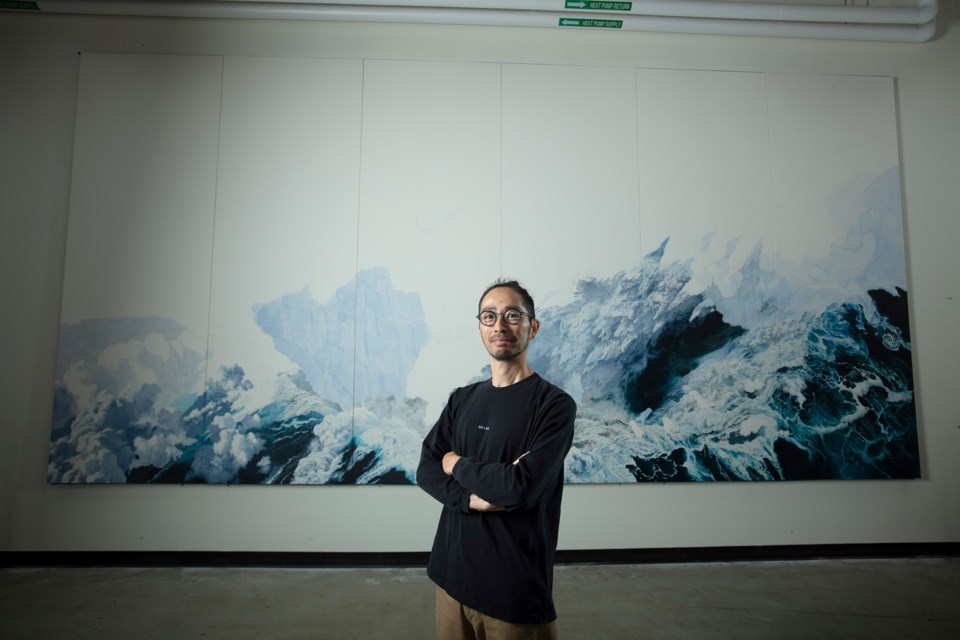Sea to Sky art enthusiasts have something new to feast their eyes on this summer as the Audain Art Museum unveils Manabu Ikeda: Flowers from the Wreckage. The exhibition will be on display until Oct. 9, and showcases the rich and detailed work of Manabu Ikeda. Born in Saga, Japan in 1973, Ikeda has travelled extensively throughout Asia and North America, with stints in Vancouver and Madison, Wis. under his belt.
Unlike some artists who dabble in multiple mediums, Ikeda has remained stylistically consistent throughout his career, drawing on paper with pen and acrylic ink. Over time, he has branched out from using solely black ink to incorporate more diverse and complex techniques into his repertoire.
“[Ikeda’s] work really speaks to humanity at large,” remarks Audain curator Kiriko Watanabe. “He expresses a number of issues associated with living on the Earth.”
From the ashes
Central to many of Ikeda’s drawings are themes of nature, grief, resilience, and the dynamic relationships between human civilization and the natural world. Such metaphors are especially prevalent in three of the exhibition’s most notable pieces: Foretoken, Meltdown, and Rebirth. Together, they relate to the 2011 Tōhoku earthquake and tsunami, Fukushima Daiichi nuclear disaster and their impacts on the collective Japanese psyche.
The first of the trio, Foretoken, was conceptualized in 2008 and depicts a giant, intricate wave. Said wave is not one of water, but ice, with people enjoying various winter sports upon it—reflecting in part Ikeda’s own love of skiing. Needless to say, his view of the painting and that of others irrevocably changed three years later, when Japan was rocked by the most powerful earthquake in its history.
Ikeda was in Vancouver at the time. According to Watanabe, he was afflicted with emotional turmoil upon learning of the tragedy, and struggled for a while to make new art. Newfound inspiration arose from visits to Banff and Jasper, which spurred Ikeda in 2013 to create Meltdown, which depicts a sprawling, industrial metroplex suspended above a lake by a gargantuan block of ice.
The theme is poignant: byproducts of human habitation and innovation will eventually melt the ice, causing everything to plummet into a previously-calm lake and trigger ecological catastrophe.
“That work is derived from the earthquake and the subsequent nuclear disaster in Japan, but his messages are not just for people in Japan,” Watanabe comments. “The reason that he incorporates elements from different places is because these disasters could really happen anywhere.”
Ikeda’s masterpiece, Rebirth, took more than three full years (2013 to 2016) to complete. True to its name, the three-by-four-metre drawing—which incorporates transparent watercolour in addition to pen and acrylic ink—embodies an optimistic message that life is cyclical and that humanity can rise above even the greatest calamities.
The mighty tree dominating the piece was inspired by a visit Ikeda took to Japan’s disaster-stricken areas after the earthquake. While there, Ikeda remembered seeing one skinny tree that remained standing amidst a tsunami-devastated landscape. It was a stark symbol of resilience that he won’t soon forget.
In the details
As patient as he is detail-oriented, Ikeda does not cut corners in the creative process, and many of his drawings contain more than meets the eye.
“The main characteristic of his work is the meticulously-drawn detail that he delivers,” says Watanabe. “Because they’re so small, so microscopic, even the viewer will have to work quite hard to … comprehend what it is that they’re looking at.
“From a distance, you may see a wrecked ship or an old tree, and that’s the larger image of the artwork. Then when you start to observe details, you realize what you’re looking at may not be what you originally thought it was.”
Outside of drawing and skiing, Ikeda enjoys fishing, hiking, and catching insects, but nature is not his sole source of inspiration. He is also influenced by elements of Japanese culture, particularly from the 1970s and 1980s—the heyday of anime. Ikeda has enjoyed a variety of anime shows and mangas from Dragon Ball to Captain Tsubasa, and his approach to drawing is at times reminiscent of a manga artist.
Though he hasn’t experienced hardship on the level of the Tōhoku earthquake, Ikeda has faced adversity in his own career. He broke his right arm skiing in the mid-2010s and was forced to teach himself how to draw with his left hand. In fact, he managed to illustrate the upper left portion of Rebirth as a southpaw.
According to Watanabe, Flowers from the Wreckage is a survey of Ikeda’s work that spans 20 years, with the oldest piece in the exhibition dated 1998 and the most recent from 2021. Until Aug. 30, Audain guests will also be able to witness the artist progress on his latest (currently untitled) drawing and learn more about his techniques during studio hours on Thursdays, Fridays and Saturdays in the museum’s Upper Galleries.




